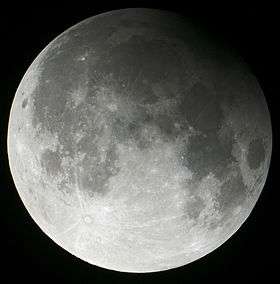February 1989 lunar eclipse
| Total Lunar Eclipse February 20, 1989 | |
|---|---|
| (No photo) | |
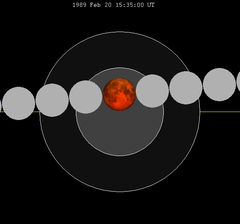 The moon passes west to east (right to left) across the Earth's umbral shadow, shown in hourly intervals. | |
| Series | 123 (51 of 73) |
| Duration (hr:mn:sc) | |
| Totality | |
| Partial | |
| Penumbral | |
| Contacts | |
| P1 | UTC |
| U1 | |
| U2 | |
| Greatest | |
| U3 | |
| U4 | |
| P4 | |
A total lunar eclipse took place on February 20, 1989, the first of two total lunar eclipses in 1989.
Visibility
It was completely visible from Australia and most of Asia. It was visible setting in eastern Africa and Europe. In the Philippines, the lunar eclipse was very visible throughout the country since the modern lunar eclipse happened on July 26, 1953.
It was also preceded by the twin total lunar eclipses on April 24, 1986 and October 17, 1986. The next one happened on February 9, 1990.
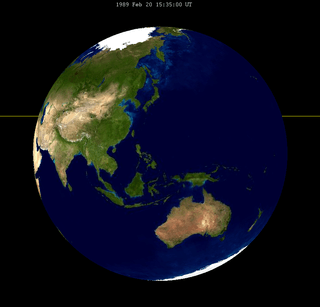
Relation to other lunar eclipses
Lunar year series (354 days)
| Descending node | Ascending node | |||||
|---|---|---|---|---|---|---|
| Saros | Date | Type Viewing |
Saros | Date Viewing |
Type Chart | |
| 113 | 1988 Mar 03 |
Penumbral |
118 | 1988 Aug 27 |
Partial | |
| 123 | 1989 Feb 20 |
Total  |
128 | 1989 Aug 17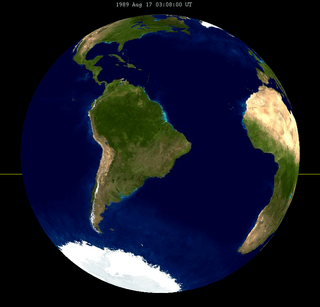 |
Total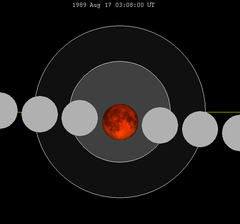 | |
| 133 | 1990 Feb 09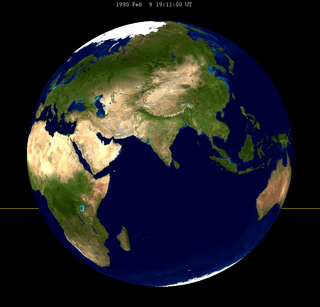 |
Total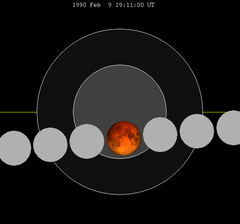 |
138 | 1990 Aug 06 |
Partial | |
| 143 | 1991 Jan 30 |
Penumbral |
148 | 1991 Jul 26 |
Penumbral | |
| Last set | 1987 Apr 14 | Last set | 1987 Oct 07 | |||
| Next set | 1991 Dec 21 | Next set | 1991 Jun 27 | |||
Tritos series
The tritos series repeats 31 days short of 11 years at alternating nodes. Sequential events have incremental Saros cycle indices.
This series produces 20 total eclipses between April 24, 1967 and August 1, 2167, only being partial on November 19, 2021.
| Tritos eclipse series (subset 1901–2100) | ||||||
|---|---|---|---|---|---|---|
| Descending node | Ascending node | |||||
| Saros | Date Viewing |
Type chart |
Saros | Date Viewing |
Type chart | |
| 115 | 1901 Oct 27 |
Partial |
116 | 1912 Sep 26 |
Partial | |
| 117 | 1923 Aug 26 |
Partial |
118 | 1934 Jul 26 |
Partial | |
| 119 | 1945 Jun 25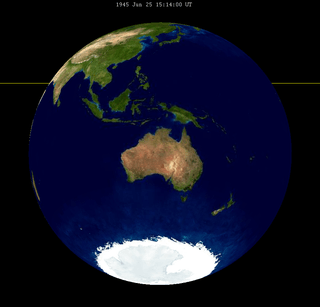 |
Partial |
120 | 1956 May 24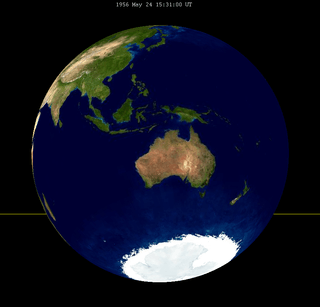 |
Partial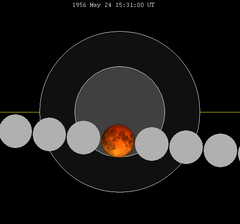 | |
| 121 | 1967 Apr 24 |
Total |
122 | 1978 Mar 24 |
Total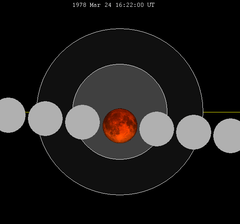 | |
| 123 | 1989 Feb 20 |
Total |
124 | 2000 Jan 21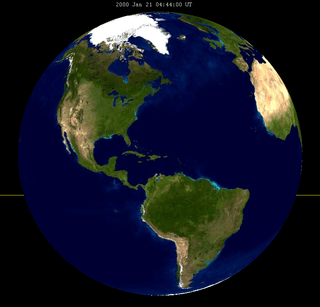 |
Total | |
| 125 | 2010 Dec 21 |
Total |
126 | 2021 Nov 19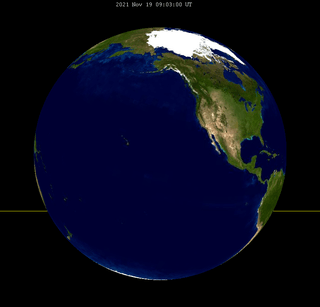 |
Partial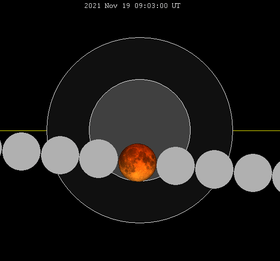 | |
| 127 | 2032 Oct 18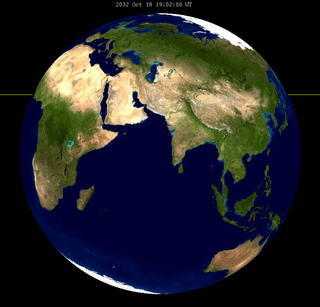 |
Total |
128 | 2043 Sep 19 |
Total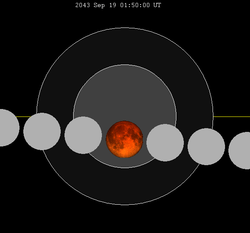 | |
| 129 | 2058 Jun 6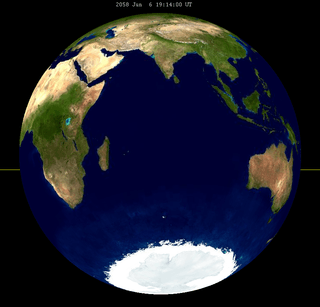 |
Total |
130 | 2069 May 6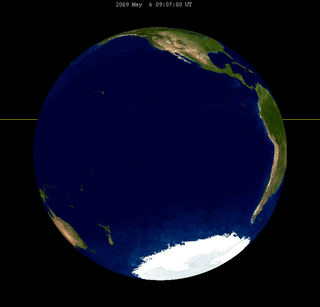 |
Total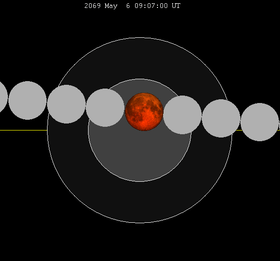 | |
| 131 | 2080 Apr 4 |
Total |
132 | 2091 Mar 5 |
Total | |
Saros series (18 years 11 days)
Lunar saros series 123, repeating every 18 years and 11 days, has 25 total lunar eclipses. The first total lunar eclipse of this series was on July 16, 1628, and last will be on April 4, 2061. The two longest occurrence of this series were on September 20, 1736 and October 1, 1754 when totality lasted 106 minutes.[1]
It last occurred on February 10, 1971 and will next occur on March 3, 2007.
Metonic cycle (19 years)
This is the third of five Metonic lunar eclipses.
The Metonic cycle repeats nearly exactly every 19 years and represents a Saros cycle plus one lunar year. Because it occurs on the same calendar date, the earth's shadow will in nearly the same location relative to the background stars.
| Descending node | Ascending node | |||||
|---|---|---|---|---|---|---|
| Saros | Date | Type | Saros | Date | Type | |
| 103 | 1951 Feb 21 | Penumbral | 108 | 1951 Aug 17 | Penumbral | |
 |
 | |||||
| 113 | 1970 Feb 21 | Partial | 118 | 1970 Aug 17 | Partial | |
 |
 | |||||
| 123 | 1989 Feb 20 | Total | 128 | 1989 Aug 17 | Total | |
 |
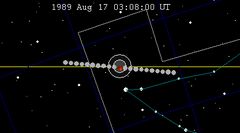 | |||||
| 133 | 2008 Feb 21 | Total | 138 | 2008 Aug 16 | Partial | |
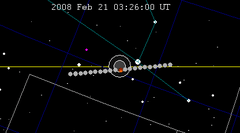 |
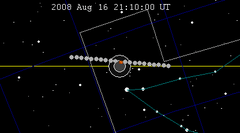 | |||||
| 143 | 2027 Feb 20 | Penumbral | 148 | 2027 Aug 17 | Penumbral | |
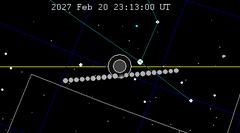 |
 | |||||
See also
Notes
External links
- 1989 Feb 20 chart Eclipse Predictions by Fred Espenak, NASA/GSFC
| Wikimedia Commons has media related to Lunar eclipse of 1989 February 20. |
